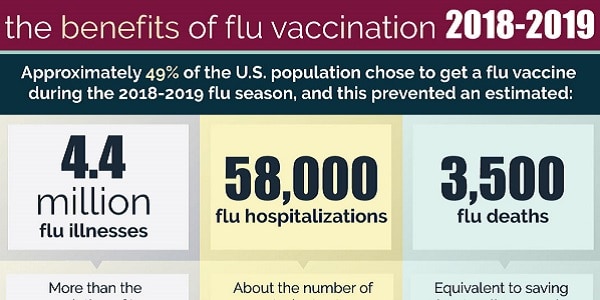Estimated Flu Illnesses, Medical Visits, and Hospitalizations Prevented by Vaccination in the United States — 2019 ... - CDC

This web page provides estimates on the burden of influenza (flu) and the effects of annual flu vaccination in the United States for the 2019–2020 flu season. While previous updates to the prevented burden estimates for the 2019-2020 season included preliminary input data, this update provides the final estimates for flu vaccine prevented burden for the 2019-2020 season.
For the past several years, CDC has used a model to estimate the numbers of flu illnesses, medical visits, hospitalizations, and deaths and has also estimated the effect of flu vaccination on these outcomes in the United States (1-6). The methods used to calculate the estimates have been described previously (1,2,6). CDC uses the estimates of the impact of flu vaccination to inform policy and communications promoting influenza vaccination as the best way to prevent flu.
2019–2020 Estimates of Burden Prevented by Flu Vaccination
CDC estimates that during the 2019–2020 season 36 million people were ill, 16 million people went to a health care provider, 390,000 were hospitalized, and 25,000 died with flu (7). In March 2020, Severe Acute Respiratory Syndrome Coronavirus 2 (SARS-CoV-2) began circulating in the United States. As a result of measures implemented to reduce transmission of SARS-CoV-2, influenza virus circulation rapidly declined, and flu circulation ended earlier than in prior seasons. Overall, influenza A(H1N1)pdm09 viruses were the most commonly reported influenza viruses this season. The number of flu-associated illnesses, medically attended illnesses, hospitalizations, and deaths were lower than some more recent seasons and similar to other seasons during which influenza A(H1N1)pdm09 viruses dominated (8).
During the 2019-2020 season, flu vaccine coverage ranged from 38% among those aged 18-49 years to 76% among those aged 6 months-4 years. Vaccine effectiveness was 39% for all age groups and was lowest among children aged 5-17 years (32%) and highest among children aged 6 months-4 years (44%) (9-11). Applying this information, influenza vaccination prevented an estimated 7.1 million illnesses, 3.4 million medical visits, 100,000 hospitalizations, and 7,100 deaths due to influenza during the 2019-2020 season. Flu vaccination prevented an estimated 7.1 million illnesses, 3.45 million medical visits, 100,000 hospitalizations, and 7,200 deaths due to flu during the 2019-2020 season. The number and proportion of flu-associated hospitalizations prevented by vaccination during 2019–2020 varied by age group, due to age-specific differences in flu burden, vaccine coverage, and vaccine effectiveness. Overall, vaccination prevented 21% of hospitalizations across all age groups. Vaccination prevented the lowest proportion of flu-related hospitalizations among adults aged 18 to 49 years, the age group in which vaccination coverage is lowest. Vaccination prevented the greatest proportion of outcomes among children aged 6 months to 4 years, an age group in which there was high vaccine uptake and the vaccine effectiveness was greatest.
Annual flu vaccination is the best way to protect against flu and associated complications. Improvements in vaccine coverage could also provide great public health benefit, producing even greater reductions in illnesses and lowering demands on the health system. During flu seasons, the health care system, including outpatient clinics, emergency departments, and hospitals, can experience high patient volumes. Any reduction in flu-related medical visits and hospitalizations can reduce demands on the health care systems and improve health care providers' abilities to provide the best care. Strategies to improve flu vaccine coverage include: using patient reminder/recall systems aided by immunization information systems; expanding access to flu vaccination at pharmacies, workplaces, and schools; and organizing mobile and/or outdoor vaccination clinics.
Comments
Post a Comment